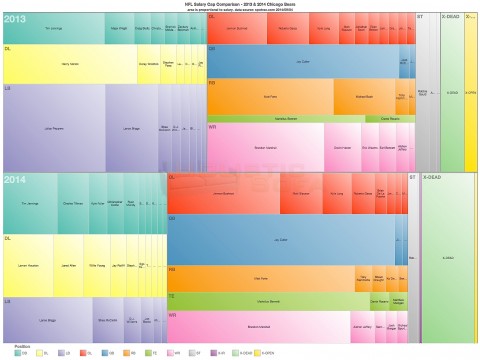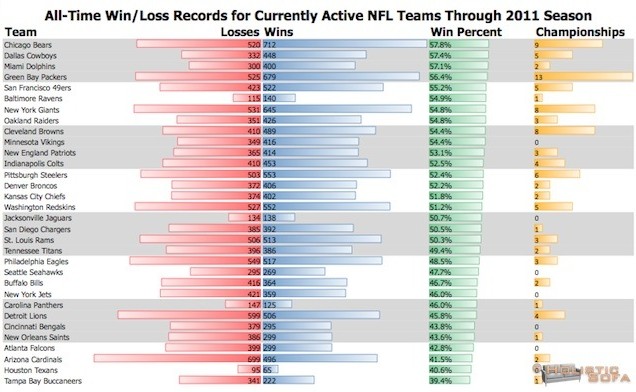
NFL Chicago Bears salary cap comparison for the 2013 and 2014 seasons. Area is proportional to salary.
My other favorite NFL team is the local Chicago Bears. There have been some big changes this year for the Bears, as the visualization here shows. Player are represented by individual rectangles, with the area of each rectangle being proportional to the player’s salary for that year. The players are grouped into player positions and colored similarly. Then the positions are grouped into Defense, Offense and Special Teams which are shown as three stacks of position groups from left to right. Dead money from departed players and injured reserve are shown towards the right side of each row, along with open salary cap space. Finally, all of the above are collected in to two major rows for the 2013 (top) and 2014 (bottom) season. Click on the image to see a full size version of the image with greater detail.
A few things jump out from looking at this visual.
- Julius Peppers was collecting a huge portion of the overall defensive spending in 2013. Visually it appears to be around 20%.
- The dead money component (X-DEAD) jumped significantly in 2014. This is due almost entirely to the $8,000,000 cap hit created with the departure of Peppers.
- 2014 signings of Lamar Houston and Jared Allen amount to less than what Peppers was making in 2013. I think this could be a good tradeoff for the Bears as Peppers was a good but not dominating contributor last season. The distribution of spending between DL, LB and DB is much more even in 2014.
- The Bears are spending much more on offense than defense this year. In 2013 the spending between the two categories was more equal. In 2013 the Bears offense was ranked much higher than their defense. It will be interesting to see if the rankings diverge or converge with the new spending pattern this season.
- Spending on defense is down and spending on offense is up in 2014 for the Bears.
Overall impressions: the Chicago Tribune had an article in the Opening Week Sunday edition pointing out that three recent Superbowl champs made it there with an offense ranked 8th or higher and a defense ranked 21st or lower. The Bears certainly look capable of repeating that formula this year. Last year that only got them an 8-8 record though, so it is obviously no guarantee of success. I am a bit concerned about the age of the players and potential weakness at LB and Safety, but if they can hold together with the upgraded defensive line then there is a good chance the overall defense could improve this year. I haven’t done a schedule analysis yet, but the information here is telling me that 10-6 is a good possibility this year.


